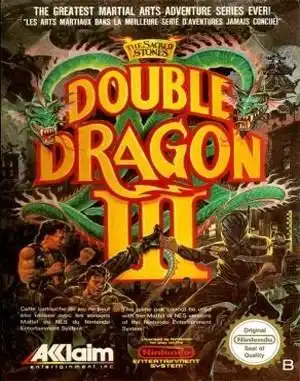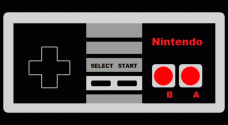The Double Dragon series holds a special place in the hearts of many retro gamers. The original arcade hit defined the beat 'em up genre, and its sequel, [Double Dragon II: The Revenge](https://weplayretro.games/online/double-dragon-ii-the-revenge/), particularly the NES version, is often lauded as a masterpiece. Then came Double Dragon III: The Sacred Stones. Released in 1991 for the NES (following an arcade version), this third installment took the Lee brothers, Billy and Jimmy, on a globe-trotting adventure. But while the premise sounded grand, the execution left many players scratching their heads and throwing their controllers.
Unlike the familiar urban landscapes of the first two games, Double Dragon III: The Sacred Stones sends Billy and Jimmy on a worldwide quest. Their mission? To find five mystical Sacred Stones scattered across Egypt, Italy, China, and Japan. Why? To rescue a kidnapped Marian, of course, because what else would drive the Lee brothers? This time, they're guided by a mysterious fortune teller named Hiruko. It was certainly a departure from the street brawling, aiming for a more epic, Indiana Jones-style adventure vibe.
New Faces, Familiar Fists (Sort Of)
One of the interesting additions in Double Dragon III: The Sacred Stones was the introduction of new playable characters. As you progress through the game, you encounter and defeat martial arts masters Chin Seimei and Ranzou Hattori. Once beaten, they join your cause, becoming playable characters with their own unique movesets and limited-use secondary weapons (like Chin's iron claw or Ranzou's shuriken). This added a layer of strategy, allowing you to switch between characters mid-game, assuming you could recruit them.
The Sacred Stones Challenge: A Trial by Fire
If the Double Dragon series was known for anything besides its brawling, it was its difficulty. But Double Dragon III: The Sacred Stones took it to another level entirely. This game is notorious, and not always in a good way, for its brutal challenge.
Controls & Combat Woes
While the controls generally mirrored Double Dragon II, executing specific moves like the cyclone kick or flying knee felt inconsistent and often unresponsive. In a game where precise combat is key, this finicky control scheme could lead to frustrating moments, leaving you vulnerable to enemy attacks. Basic punches and kicks were reliable, but mastering the more advanced techniques necessary to survive felt like a gamble.
A Brutal Learning Curve (Or Wall?)
The game starts you off with zero extra lives. That's right, one life for each brother. You only gain additional lives much later in the game, and even then, they are scarce. Coupled with relentless enemy waves that could easily trap you in stun-lock chains and short, punishing stages, the initial levels felt incredibly unfair. Simply making it past the first few screens was a significant achievement for many players back in the day.
Permanent Pain
Adding to the difficulty was the controversial decision to implement permanent character death. If Billy or Jimmy (or Chin or Ranzou) lost all their health, they were gone for good for that playthrough. This meant losing access to their unique abilities and potentially leaving you with only one character to face the increasingly difficult later stages. It raised the stakes, but also added another layer of frustration for players struggling with the core mechanics.
Different Stones, Different Systems
It's worth noting that there are key differences between the arcade version of Double Dragon III and the NES version, The Sacred Stones. The arcade game is often cited as being even worse, featuring a controversial system where players had to purchase extra lives, weapons, and even special moves with real-world money (or tokens). The NES version, while still incredibly difficult and flawed, removed this predatory mechanic but introduced its own set of frustrating design choices, leading many to debate which version was the lesser of two evils.
Is It Worth Revisiting?
So, where does Double Dragon III: The Sacred Stones stand today? It's certainly not the beloved classic that Double Dragon II is. Its difficulty often feels cheap rather than challenging, the controls can be frustrating, and the permanent death mechanic is divisive.
However, for the truly dedicated retro gamer, especially one fascinated by the history and evolution (or sometimes, devolution) of classic series, Double Dragon III offers a unique, albeit painful, experience. It's a snapshot of a time when developers were experimenting, sometimes successfully, sometimes not. If you've conquered the first two games and are looking for a serious test of patience and skill, or simply want to see where the series went next, it might be worth a look. Just be prepared for a tough fight. You can often find ways to play classic games like this through digital storefronts that package retro titles or via emulation with tools like DOSBox for potential PC ports.
FAQ
Q: Is Double Dragon III: The Sacred Stones considered a good game? A: Generally, no. It's widely considered one of the weaker entries in the series due to its excessive difficulty, frustrating controls, and controversial mechanics like permanent character death.
Q: Why is Double Dragon III so difficult? A: Key reasons include starting with no extra lives, inconsistent controls, enemies that can easily stun-lock you, and the permanent death of characters once their health is depleted.
Q: Are there different versions of Double Dragon III?
A: Yes, there's an arcade version and the NES version, The Sacred Stones. The arcade version is infamous for its pay-to-win mechanics, while the NES version has its own distinct set of challenges and design flaws.
Q: Can you play as characters other than Billy and Jimmy in Double Dragon III: The Sacred Stones? A: Yes, you can recruit Chin Seimei and Ranzou Hattori after defeating them in battle, adding them to your roster of playable characters.


